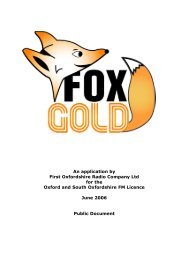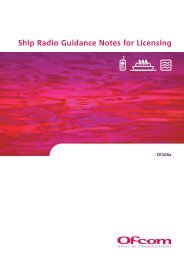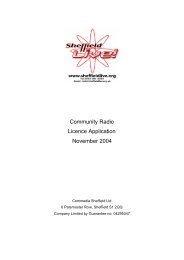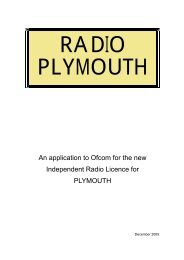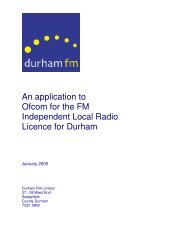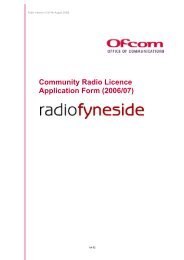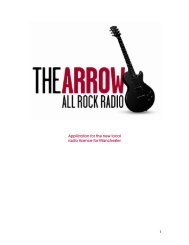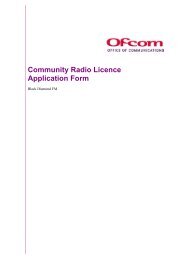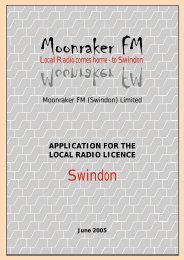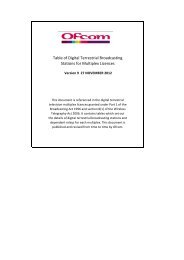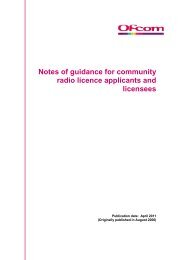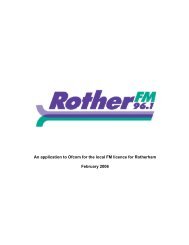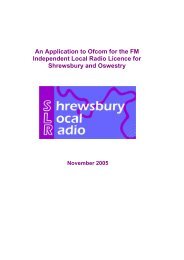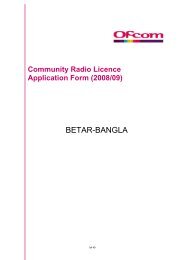Piccadilly Talk - Ofcom Licensing
Piccadilly Talk - Ofcom Licensing
Piccadilly Talk - Ofcom Licensing
Create successful ePaper yourself
Turn your PDF publications into a flip-book with our unique Google optimized e-Paper software.
PROJECT PHASE<br />
(type)<br />
Establishing views<br />
of advertising<br />
community<br />
(Qualitative &<br />
quantitative)<br />
A) OBJECTIVE B) SPECIFIC<br />
QUESTIONS<br />
Seek the views of<br />
advertising market<br />
of current radio<br />
stations and<br />
proposed format<br />
Establish appeal of<br />
using the proposed<br />
station as an<br />
advertising<br />
medium.<br />
Investigate how<br />
advertising<br />
community feels<br />
the station will<br />
impact on current<br />
radio stations on<br />
offer in the area.<br />
CONDUCTED BY C) METHODOLOGY D) SIZE AND<br />
COMPOSITION OF<br />
SAMPLE<br />
Emap Advertising &<br />
Key 103<br />
Advertising Staff<br />
Informal interviews<br />
& short<br />
questionnaires<br />
8 informal<br />
interviews with<br />
Heads of Radio and<br />
29 questionnaires<br />
with local<br />
advertisers<br />
E) WHEN AND<br />
WHERE RESEARCH<br />
WAS CONDUCTED<br />
August 2006,<br />
Manchester &<br />
London<br />
F) A summary of the main findings from the research, showing how these demonstrate<br />
evidence of demand for the service proposed;<br />
Executive Summary<br />
PICCADILLY TALK has exceptionally strong and broad appeal among the population in the proposed TSA.<br />
Almost 6 in 10 of adults interviewed said they would be very or quite likely to tune in, of which 14% said they would<br />
be very likely to listen.<br />
The format holds particular appeal to 25-64s.<br />
24% of BBC Radio Manchester and 23% of Five Live listeners said they would be very likely to tune in to<br />
PICCADILLY TALK.<br />
<br />
Our qualitative research reinforces this finding with those respondents already accepting talk based radio or stations<br />
with stronger talk elements, being predisposed to the proposed new station<br />
Respondents were particularly drawn to the idea of presenters with strong personalities, the mix of serious and<br />
humorous and “speaks its mind” attitude of the station.<br />
The qualitative research indicated the main market for this station is likely to be women 30-55 and men 40-55,<br />
re-enforced by quantitative findings which showed a slightly wider age band (25yrs-64yrs) finding the format<br />
appealing.<br />
Our quantitative research revealed that people over the age of 45 did not feel there was any station clearly aimed<br />
at them, unlike under 45s who felt there were clearly two stations “for them” – Galaxy and Key 103.<br />
During both the qualitative and quantitative stages of research we investigated what was the most appropriate and<br />
interesting editorial content for the station. Local information was vital be-it local news - economic issues or headlines<br />
from the area to leisure information like What’s On.<br />
PICCADILLY TALK will increase radio listening in the area with 56% of potential listeners saying that they would<br />
increase their overall hours listening to the radio to incorporate the station into their repertoire.<br />
Our extensive research programme has provided us with convincing evidence of the appeal of PICCADILLY TALK and how<br />
it will boost the commercial radio market in the Manchester area. The results have been used to refine and develop our<br />
programme schedule ensuring we will deliver to the people of Manchester and surrounding area precisely what they want<br />
from their new radio station.<br />
Section 105 (D): Evidence of Local Demand or Support 43



